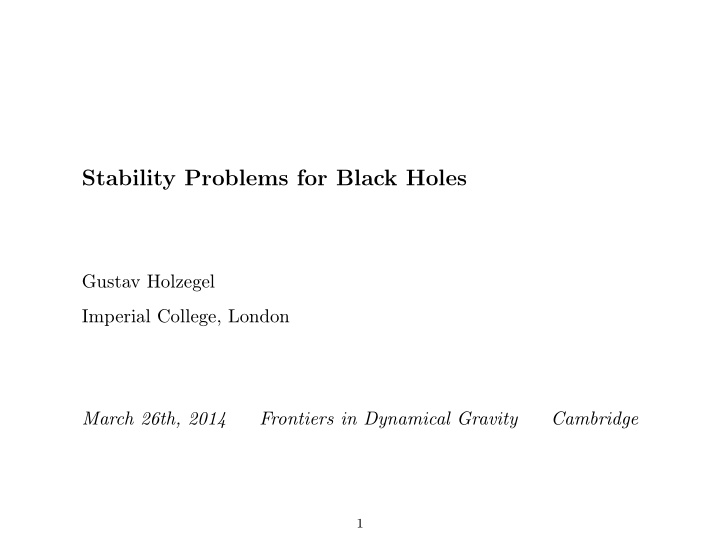



Stability Problems for Black Holes Gustav Holzegel Imperial College, London March 26th, 2014 Frontiers in Dynamical Gravity Cambridge 1
Two Problems Problem 1: Prove linear and non-linear stability of Schwarzschild and Kerr. Problem 2: Prove (in)stability of Kerr-AdS. Of course, (in)stability of pure AdS is also open (previous talks). I will report on recent progress concerning the above two problems. 2
The Strategy Einstein’s equations are wave equations: � g g µν = N ( g, ∂g ) . (Asymptotic) stability is based on decay . 1. Understand � g ψ = 0 for g a black hole metric 2. Understand non-linear toy-problems: � g ψ = ( ∂ψ ) 2 3. Reintroduce the tensorial nature (a) system of gravitational perturbations (linear) (b) full problem (non-linear) 3
Difficulties and Caveats 1. Decay needs to be sufficiently strong. The methods should be robust. → quantify the effect of ergosphere, trapped null-geodesics and the redshift on wave propagation. 2. Non-linearities need to have structure 3.(a) Gauge issues, stationary modes (b) mass and angular momentum of final state? 4
Problem 1 5
Results I: Quantitative decay of the linear scalar problem Theorem 1. [Dafermos–Rodnianski–Shlapentokh-Rothman 2005-2014] Solutions of the linear wave equation � g M,a ψ = 0 for g M,a a subextremal member of the Kerr-family decay polynomially in time on the black hole exterior. → extremal case (Aretakis; Lucietti, Murata, Reall, Tanahashi) 6
Results II: Decay for non-linear toy-models Theorem 2. [J.Luk 2010] Small data solutions of the non-linear wave equation � g M,a ψ = N nc ( ψ, ∂ψ ) for g M,a a Kerr spacetime with | a | ≪ M exist globally in time and decay polynomially in time on the black hole exterior. 7
Results III: Linear Stability of Schwarzschild Regarding item 3.(b) above, we were recently able to prove Theorem 3. [Dafermos–G.H.–Rodnianski] The Schwarzschild solution is linearly stable: Solutions to the system of gravitational perturbations decay to a linearised Kerr solution polynomially in time with quantitative decay rates and constants depending only on norms of the initial data. Linear stability of Kerr is completely open! 8
Mode stability is NOT linear stability! • In the old days, people knew very well the difference between mode stability and linear stability, see for instance Whiting’s 1989 paper “Mode Stability of the Kerr solution” • Nowadays, one often sees Whiting being cited erroneously for proving linear stability of Kerr! Mode stability excludes a particular type of exponentially growing solution. It does not rule out exponential growth in general let alone show that solutions are bounded or decay. The latter would be linear stability. 9
Key Observations 1. linearization in double null-gauge 2. a quantity (combination of derivatives of curvature and connection coefficients) which (a) decouples from the system (b) satisfies a “good” wave equation (NOT Teukolsky) (c) controls all other dynamical quantities (hierarchy). → Chandrasekhar 3. all insights from the wave equation enter 10
What is left to do? 1. A non-linear problem which doesn’t need Kerr: axisymmetric perturbations of Schwarzschild with a = 0 2. Generalise the linear stability result to Kerr 3. Do the full problem 11
Problem 2 12
Follow the strategy for AdS black holes... Study � g ψ − Λ 3 αψ = 0 with α < 9 4 (Breitenlohner–Freedman) . Well-posedness non-trivial. (Breitenlohner–Freedman, Bachelot, Ishibashi–Wald, GH, Vasy, Warnick) 13
Theorem 4. [G.H.–Smulevici 2011–2013] Let ( R , g ) denote the exterior of a Kerr-AdS with parameters M > 0 , | a | < l . Consider the massive wave equation (with Dirichlet boundary conditions) � g ψ + α l 2 ψ = 0 with α < 9 / 4 1. The solutions arising from data prescribed on Σ 0 remain uniformly bounded, provided r 2 hoz > | a | l holds: k k � � | D i ψ | 2 ≤ C � � | D i ψ | 2 for k ≥ 1 Σ t⋆ Σ 0 i =1 i =1 2. The solutions satisfy for t ⋆ ≥ 2 C � � | Dψ | 2 ≤ | Dψ | 2 + | D 2 ψ | 2 (log t ⋆ ) 2 Σ t⋆ Σ 0 3. The log-decay is sharp. 14
Comments 1. The boundedness relies on the existence of a globally time-like Killing field in the non-superradiant regime (Hawking–Reall) Growing modes if HR is violated [Press-Teukolsky, Shlapentokh-Rothman] 2. Note the loss of derivatives (trapping) and the slow decay rate. This is due to a stable trapping phenomenon. In AdS-Schwarzschild any fixed l mode decays exponentially! 3. Construction of quasi-modes (see also Gannot) Application: ultracompact neutron stars [Keir] Generalisations: [G.H.–Warnick 2013] Boundedness for Neumann and some Robin boundary conditions. 15
Non-linear problems The log -decay for the linear problem does not allow us to follow the usual strategy. → Too weak to prove small data global existence. • Instability? [G.H-Smulevici] • Stability? [Dias–Horowitz–Marolf–Santos] • “Doable” problem: Construction of solutions converging to Kerr-AdS exponentially fast [cf. Dafermos–G.H.–Rodnianski 2013, Friedrich 1995] 16
Recommend
More recommend